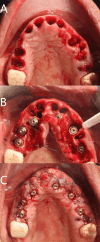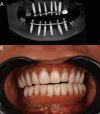Immediate Loading Implant-Supported Fixed Full-Arch Rehabilitation Using a New Clinical Decision-Support System: A Case Series
- PMID: 39328709
- PMCID: PMC11425992
- DOI: 10.7759/cureus.67879
Immediate Loading Implant-Supported Fixed Full-Arch Rehabilitation Using a New Clinical Decision-Support System: A Case Series
Abstract
Background Implant-supported full-arch rehabilitation is an effective treatment for edentulous patients. It restores mastication, facial aesthetics, and psychological well-being. Patient-related outcome measures support the validity of this approach, emphasizing the importance of effective prosthodontic interventions for this patient population. This study aims to present a case series for fixed implant-supported full-arch rehabilitation using the new Carames classification (CC). Methods A total of seven patients with generalized periodontitis or non-restorable multiple teeth were indicated for extraction and replacement with a fixed full-arch implant-supported prosthesis. According to the Carames classification, most cases were categorized as CCI or CCII classes for both the upper and lower jaws. Before the surgery, screw-retained provisional complete dentures were constructed and adjusted for the vertical occlusal dimension and smile lines. After the extractions, 70 implants were immediately placed in one or both arches for the seven patients, followed by bone grafts with the dual-zone grafting technique. Multi-unit abutments were then placed and welded to a metal bar for stable fixation. The provisional denture was fitted snugly over the metal bar for immediate functional loading. After three months of healing, it was used as a biocopy to fabricate the final prosthesis. The implant loss and the peri-implant marginal tissue health status were assessed annually for three years. Statistical analysis compared the marginal bone loss as a change from the baseline over the year. Results No implant or prosthesis loss was reported over the three years. Peri-implant marginal tissue health showed promising results without bleeding and suppuration on probing and probing depths between 3 and 3.5 millimeters. Marginal bone loss was minimal over the three years, with some cases showing bone gain. Conclusion Using the Carames classification as a clinical decision support system in implant-supported full-arch rehabilitation showed promising results in peri-implant tissue health and no implant loss during three years of follow-up. The implant placement and prosthesis fabrication protocol in this study could be valuable for further research.
Keywords: carames classification; full-arch rehabilitation; immediate functional loading; immediate implant; peri-implant marginal tissue health.
Copyright © 2024, Bahaa et al.
Conflict of interest statement
Human subjects: Consent was obtained or waived by all participants in this study. Animal subjects: All authors have confirmed that this study did not involve animal subjects or tissue. Conflicts of interest: In compliance with the ICMJE uniform disclosure form, all authors declare the following: Payment/services info: All authors have declared that no financial support was received from any organization for the submitted work. Financial relationships: All authors have declared that they have no financial relationships at present or within the previous three years with any organizations that might have an interest in the submitted work. Other relationships: All authors have declared that there are no other relationships or activities that could appear to have influenced the submitted work.
Figures







Similar articles
-
Full arch immediate occlusal loading using site specific implants: A clinical series of 10 patients (13 arches).J Prosthodont. 2023 Mar;32(3):204-213. doi: 10.1111/jopr.13620. Epub 2022 Dec 2. J Prosthodont. 2023. PMID: 36375088
-
Do we need abutments at immediately loaded implants supporting cross-arch fixed prostheses? Results from a 5-year randomised controlled trial.Eur J Oral Implantol. 2018;11(4):397-407. Eur J Oral Implantol. 2018. PMID: 30515481 Clinical Trial.
-
Immediately loaded distally cantilevered fixed mandibular prostheses supported by four implants placed in both in fresh extraction and healed sites: 2-year results from a prospective study.Eur J Oral Implantol. 2014 Summer;7(2):173-84. Eur J Oral Implantol. 2014. PMID: 24977253 Clinical Trial.
-
Immediate flapless full-arch rehabilitation of edentulous jaws on 4 or 6 implants according to the prosthetic-driven planning and guided implant surgery: A retrospective study on clinical and radiographic outcomes up to 10 years of follow-up.Clin Implant Dent Relat Res. 2022 Dec;24(6):831-844. doi: 10.1111/cid.13134. Epub 2022 Oct 5. Clin Implant Dent Relat Res. 2022. PMID: 36197040 Free PMC article.
-
Maxillary Complete Arch Oral Implant Treatment for Fixed-Denture Immediate Function.Atlas Oral Maxillofac Surg Clin North Am. 2025 Sep;33(2):105-115. doi: 10.1016/j.cxom.2025.04.001. Epub 2025 Jun 27. Atlas Oral Maxillofac Surg Clin North Am. 2025. PMID: 40818859 Review. No abstract available.
References
-
- The future of complete dentures in oral rehabilitation. A critical review. Carlsson GE, Omar R. J Oral Rehabil. 2010;37:143–156. - PubMed
-
- Edentulism as part of the general health problems of elderly adults. Polzer I, Schimmel M, Müller F, Biffar R. https://pubmed.ncbi.nlm.nih.gov/20684439/ Int Dent J. 2010;60:143–155. - PubMed
-
- Implants for elderly patients. Schimmel M, Müller F, Suter V, Buser D. Periodontol 2000. 2017;73:228–240. - PubMed
-
- Impact of timing of dental implant placement and loading: Summary and consensus statements of group 1-The 6th EAO Consensus Conference 2021. Donos N, Asche NV, Akbar AN, et al. Clin Oral Implants Res. 2021;32:85–92. - PubMed
LinkOut - more resources
Full Text Sources
